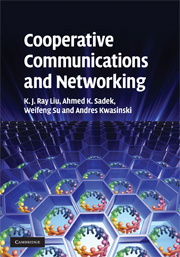Book contents
- Frontmatter
- Contents
- Preface
- Part I Background and MIMO systems
- Part II Cooperative communications
- Part III Cooperative networking
- 11 Cognitive multiple access via cooperation
- 12 Content-aware cooperative multiple access
- 13 Distributed cooperative routing
- 14 Source–channel coding with cooperation
- 15 Asymptotic performance of distortion exponents
- 16 Coverage expansion with cooperation
- 17 Broadband cooperative communications
- 18 Network lifetime maximization via cooperation
- References
- Index
18 - Network lifetime maximization via cooperation
from Part III - Cooperative networking
Published online by Cambridge University Press: 06 July 2010
- Frontmatter
- Contents
- Preface
- Part I Background and MIMO systems
- Part II Cooperative communications
- Part III Cooperative networking
- 11 Cognitive multiple access via cooperation
- 12 Content-aware cooperative multiple access
- 13 Distributed cooperative routing
- 14 Source–channel coding with cooperation
- 15 Asymptotic performance of distortion exponents
- 16 Coverage expansion with cooperation
- 17 Broadband cooperative communications
- 18 Network lifetime maximization via cooperation
- References
- Index
Summary
Extending the lifetime of battery-operated devices is a key design issue that allows uninterrupted information exchange among distributed nodes in wireless networks. Cooperative communications enables and leverages effective resource sharing among cooperative nodes. This chapter provides a general framework for lifetime extension of battery-operated devices by exploiting cooperative diversity. The framework efficiently takes advantage of different locations and energy levels among distributed nodes. First, a lifetime maximization problem via cooperative nodes is considered and performance analysis for M-ary PSK modulation is provided. With an objective to maximize the minimum device lifetime under a constraint on bit error rate performance, the optimization problem determines which nodes should cooperate and how much power should be allocated for cooperation. Moreover, the device lifetime is further improved by a deployment of cooperative relays in order to help forward information of the distributed nodes in the network. Optimum location and power allocation for each cooperative relay are determined with an aim to maximize the minimum device lifetime. A suboptimal algorithm is presented to solve the problem with multiple cooperative relays and cooperative nodes.
Introduction
In many applications of wireless networks, extending the lifetime of battery-operated devices is a key design issue that ensures uninterrupted information exchange and alleviates burden of replenishing batteries. Lifetime extension of battery-limited devices has become an important issue due to the need in sensor and ad-hoc networks.
- Type
- Chapter
- Information
- Cooperative Communications and Networking , pp. 583 - 608Publisher: Cambridge University PressPrint publication year: 2008

